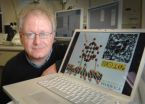(Press-News.org) DETROIT – African Americans are more likely to have a recurrence of uterine cancer despite undergoing a total hysterectomy or a hysterectomy followed by radiation therapy, according to researchers at Henry Ford Hospital in Detroit.
"The African American patients in our study had similar surgeries and radiation therapy as the Caucasian patients in the study. So access to care certainly wasn't a factor in race being identified as a negative predictor for outcome," says lead author Mohamed Elshaikh, M.D., senior staff physician in the Department of Radiation Oncology at Henry Ford Hospital.
"At this point, our next step is to take a closer look at the underlying molecular biology of these cancer cells to help identify a cause for race being a negative predictor for uterine cancer outcome."
This retrospective study – one of the largest of its kind with 750 uterine cancer patients – will be presented Nov. 2 at the 52nd annual American Society for Radiation Oncology (ASTRO) meeting in San Diego. Results also are now online in the November issue of the International Journal of Radiation Oncology.
"What's notable about our study is that we were able to confirm on a larger scale the known prognostic factors in uterine cancer, and also identify African American race as a negative predictor for outcome despite adequate surgery and radiation treatment," says Dr. Elshaikh.
Endometrial cancers mainly arise from the tissue lining the uterus. They are the most common gynecologic cancers in the United States, with more than 43,000 women diagnosed and an estimated 7,950 dying from the disease in 2010, according to the National Cancer Institute. The most common type, endometrioid adenocarcinoma, typically occurs within a few decades of menopause.
While a total hysterectomy (surgical removal of the uterus) is the most common therapeutic approach, treating physicians often differ on the next step for treatment after surgery. Some recommend radiation treatment, while others recommend no further treatment.
For the Henry Ford study, Dr. Elshaikh and his colleagues identified 750 patients with stage I or II uterine cancer who underwent a total hysterectomy between 1987 and 2008. The median age was 64, and 30 percent of the study group were African American.
The study was limited to those patients who underwent surgery and received no further treatment, and those who underwent surgery and had radiation therapy.
Recurrence-free survival for the study group at 5 years and 10 years was 94 percent and 93 percent, respectively.
The median time for uterine cancer recurrence among the group was 1.2 years.
The site of recurrence was primarily vaginal (74 percent) for those who did not receive radiation therapy.
The study also found that higher tumor grade and cancer stage, along with age (older than 65), were risk factors for uterine cancer returning after treatment. African American patients in the study also were more likely to have their cancer return than Caucasian patients.
INFORMATION:
Along with Dr. Elshaikh, Henry Ford study co-authors are Benjamin Laser, M.D.; Jared Robbins, M.D.; Michael Haley, D.O.; and Adnan Munkarah, M.D.
Research support: Henry Ford Department of Radiation Oncology.
Research at Henry Ford Hospital:
Research programs at Henry Ford Hospital, the flagship facility for Henry Ford Health System, have total annual funding exceeding $70 million. The National Institutes of Health is the primary funding source for Henry Ford's research programs. Henry Ford physicians and researchers are currently involved in more than 1,700 research projects, including those focused on stroke and traumatic brain injury, hypertension and heart disease, cancer, bone and joint diseases, the immunological basis of disease, and population studies of allergy, asthma and cancer prevention. Much of Henry Ford Hospital research is translational in nature - from bench to bedside. To this end, basic science studies run the gamut from whole animal physiology to cell and molecular biology to bioengineering with an emphasis on studies that can directly impact patient care. In 2009, Henry Ford researchers published more than 450 articles in peer-reviewed medical journals and attracted $57.4 million in external funding. To learn more, visit HenryFord.com.
The UK's National Physical Laboratory (NPL) has developed a new portable radiation detector that can assess the safety of potentially contaminated areas far quicker than current methods. The prototype was inspired by the aftermath of the murder of Alexander Litvinenko in London 2006.
Litvinenko's death was due to radiation poisoning from polonium-210. It prompted wide-scale work to assess radiation levels at almost 50 premises in London that he had been prior to his death before opening them up again to the public, costing the Health Protection Agency £2 million.
The ...
The single layer material Graphene was the subject of a Nobel prize this year but research led by a team of researchers at the University of Warwick has found molecular hooks on the surface of its close chemical cousin, Graphene Oxide, that will potentially provide massive benefits to researchers using transmission electron microscopes. They could even be used in building molecular scale mechanisms.
The research team, which includes Drs. Jeremy Sloan, Neil Wilson and PhD student Priyanka Pandey from the Department of Physics and Dr. Jon Rourke from the Department of Chemistry ...
Everybody knows that if you're physically fit, you're less likely to get a wide range of diseases. What most people don't know is that some people are "naturally" in better shape than others, and this variation in conditioning makes it difficult to test for disease risk and drug effectiveness in animal models. A new research paper published in the November 2010 print issue of The FASEB Journal (http://www.faseb.org) started out as a study to explain the strong statistical link between low aerobic exercise capacity and common diseases, but ultimately led to an animal model ...
When looking for new ways to treat aggressive brain cancers, an international team of scientists turned a new leaf and "discovered" the lowly daffodil. A new research study published in the November 2010 print issue of The FASEB Journal (http://www.fasebj.org) offers hope that a natural compound found in daffodil bulbs, called narciclasine, may be a powerful therapeutic against biologically aggressive forms of human brain cancers.
"We are planning to move a narciclasine derivative toward clinical trials in oncology within a three to four year period in order to help patients ...
Scientists are keeping their eye on a new discovery published in the November 2011 print issue of the FASEB Journal (http://www.fasebj.org) that explains what causes some genes to go out of control. Scientists have identified a "cellular switch," called eye transformer, that controls the flow of information from chemical signals outside of the cell to genes in the cell nucleus. This study demonstrates that when eye transformer is turned off, the information pathway it controls (the "JAK/STAT pathway") hyper-activates. Because this pathway exists in humans and is involved ...
ROCHESTER, Minn. -- Statistics from the Centers for Disease Control and Prevention (CDC) (http://www.cdc.gov/) rank mortality related to chronic liver disease and cirrhosis as the 12th most common cause of death in adults in the U.S. Using a modified definition that includes diseases such as viral hepatitis, liver cancer (http://www.mayoclinic.org/liver-cancer/) and obesity-related fatty liver disease (liver diseases)(http://www.mayoclinic.org/liver-disease/), Mayo Clinic-led researchers have found that liver-related mortality is as high as fourth for some age groups, and ...
Tampa, Fla. (Nov. 01, 2010) – When researchers tested three different labeling agents on three different stem cell populations to determine what effect the labeling agents had on stem cell phenotype, biological behavior and migration abilities, they found changes in stem cell proliferation depending on the type of contrast agent used.
The team of researchers from Belgium and Spain tested USPIO (ultra small superparamagnetic iron oxide) contrast agents Resovist ®, Endorem ® and Sinerem ® on mouse embryonic stem cells (mESC), rat multipotent adult progenitor cells (rMAPC) ...
While wind energy has shown strong potential as a large-scale, emission-free energy source, bat and bird collisions at wind turbines result in thousands of fatalities annually. Migratory bats, such as the hoary bat, are especially at risk for collision with wind turbines as they fly their routes in the forested ridges of the eastern U.S. This loss not only impacts the immediate area, but is also detrimental to ecosystem health nationwide—that is, bats help with pest management, pollination and the dispersal of numerous plant seeds.
Since turbine towers and non-spinning ...
With a lifelong interest in politics, University of Cincinnati researcher Muer Yang spent the last two years developing a quantitative method for allocating voting machines that could significantly reduce the average wait time of voters.
During the 2004 U.S. presidential elections, some voters waited in lines for more than 10 hours to cast their ballots, and in Ohio, the last vote was cast at 4 a.m., noted Ohio Secretary of State Jennifer Brunner in a public report. Ohio lines in the '06 and '08 elections were still so lengthy that they essentially "disenfranchised" voters ...
CAMBRIDGE, Mass., Nov. 1, 2010 -- Race may not be as important as previously thought in determining who befriends whom, suggests a new study of American college students' habits on Facebook. The findings, by a pair of sociologists from Harvard University and UCLA, appear in the current issue of the American Journal of Sociology.
The strongest attraction, the researchers found, turned out to be old-fashioned social pressure. For the average student, the tendency to reciprocate a friendly overture is seven times stronger than the attraction of a shared racial background.
"We ...

